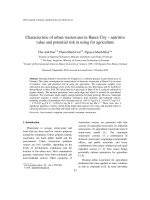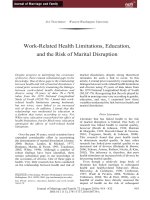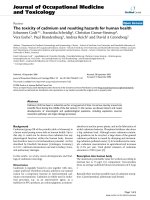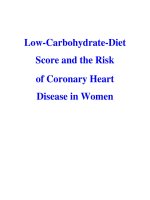Source identification and potential risk of human health of PM10 - bound polycyclic aromatic hydrocarbons from rice straw open burning in Mekong, Vietnam
Bạn đang xem bản rút gọn của tài liệu. Xem và tải ngay bản đầy đủ của tài liệu tại đây (526.52 KB, 8 trang )
Science on Natural Resources and Environment 43 (2022) 139-146
Science on Natural Resources and Environment
Journal homepage: tapchikhtnmt.hunre.edu.vn
SOURCE IDENTIFICATION AND POTENTIAL RISK
OF HUMAN HEALTH OF PM10 - BOUND POLYCYCLIC
AROMATIC HYDROCARBONS FROM RICE STRAW OPEN
BURNING IN MEKONG, VIETNAM
Pham Thi Hong Phuong, Pham Thi Mai Thao, Nguyen Thi Linh Giang
Hanoi University of Natural Resources and Environment, Vietnam
Received 21 October 2022; Accepted 28 November 2022
Abstract
In this study, we dealt with variations of PM10 - bound polycyclic aromatic
hydrocarbons (PAHs) to estimate the human health risk and identify their possible
sources from rice straw open burning (RSOB). Field experiments were conducted in
the middle of the rice �elds, away from roads, residential and industrial activities,
to collect particle-bound PAHs emitted from rice straw open burning in the Mekong
Delta. 16 PAHs in extracted solution samples were quanti�ed using GC/MS - MS
Thermo TSQ9000. The results showed that the ratio of B[a]P/B[k]F, B[a]P/∑COMB
and Fth/(Fth + Pyr) could be used as diagnostic ratios for the identi�cation of sources
from RSOB. In addition, the carcinogenic risk of PAHs on PM10 (ECR - B[a]PTEQ) on
burning samples was 238 times higher than the ECR index (10-4 ng.m-3). These results
prove that the RSOB emitted PAHs compounds on PM with a high risk to human health.
ECR - B[a]PMEQ emitted from RSOB have a very high potential for mutagenicity. These
results can be used to make a scenario about the risk of PAHs arising from RSOB for
policymaking in air quality management.
Keywords: Rice straw; Open burning; Polycyclic aromatic hydrocarbons (PAHs);
Marker; Risk; Human health.
Corresponding author. Email:
1. Introduction
Rice straw open burning (RSOB)
is a popular method to treat rice straw
because it helps to clear the elds quickly
and remove harmful organisms for new
seasons. Uncontrolled burning of rice
straw emits huge amounts of toxic air
pollutants, contributes to the increase of
greenhouse gases and seriously a�ects
air quality and human health [1 - 5].
Polycyclic Aromatic
Hydrocarbons
(PAHs) are produced from the combustion
of RSOB by incomplete combustion and
pyrolysis of organic matter. Hundreds
of single PAH are released into the
atmosphere from biomass combustion,
but 18 PAHs are commonly studied
because of their superior carcinogenicity
and mutagenicity [6, 7]. According
to the recommendations of the US
Environmental Protection Agency (US.
EPA), there are 16 PAHs that are of most
139
concern including: naphthalene (Nap),
acenaphthylene (Acy), acenaphthene
(Ace), uorene (Flu), phenanthrene (Phe),
anthracene (Ant), uoranthene (Fth),
pyrene (Pyr), benzo[a]anthracene (BaA),
chrysene (Chry), benzo[b] uoranthene
(BbF), benzo[k] uoranthene (BkF),
benzo[a]pyrene (BaP), indeno[1,2,3c,d]pyrene (I(1,2,3-c,d)P), dibenzo[a,h]
anthracene (DahA) and benzo[g,h,i]
perylene (BghiP).
Each PAH can exist in the air in the
gas phase or adsorb on dust particles
(particle phase) depending on their
physical and chemical characteristics.
They can be divided into two categories:
low-molecular-weight
compounds
consisting of PAHs with less than four
benzene rings, found mainly in the gas
phase and macromolecular compounds
with four or more benzene rings and most
are adsorbed on the dust phase [8, 9]. The
International Agency for Research on
Cancer (IARC) classi ed several PAHs
as potentially carcinogenic to humans
(Group 1, 2A or 2B). Among these are
some congeners including benzo[a]
pyrene (group 1), naphthalene, chrysene,
benz[a] antracene, benzo[k] uoranthene
and benzo[b] uoranthene (Group 2B)
[10]. The carcinogenic potential of PAHs
can be expressed by the Carcinogenic
Equivalency Factor (CEF). PAHs with 2
to 3 benzene rings in their molecules are
less likely to cause cancer and genetic
mutations. PAHs with 4 to 5 aromatic
rings or more have strong carcinogenic
and mutagenic potential. However, the
carcinogenic activity usually focuses only
on PAHs with 4, 5 and 6 aromatic rings.
PAHs with complex spatial molecular
structures often have more aggressive
oncogenic activities than planar structures
[11].
140
PAH diagnostic ratios may provide
an important tool for identifying pollution
emission sources. They can be used
to di�erentiate emissions from engine
combustion, crude oil processing products
and biomass combustion processes. The
calculated PAH rates for each source are
unknown and each pair of rates may be
speci c to a di�erent discharge source
(Table 1).
This paper discusses PAH diagnostic
rates used to identify sources of pollutant
emissions from RSOB. It focuses
primarily on the diagnostic rates of
parental PAHs because these rates are less
variable. In addition, the paper presents
a discussion of the health risks of PAH
compounds from RSOB.
Table 1. Diagnostic ratios used with their
typically reported values for particular
processes [12]
∑COMB - (FLA, PYR, BaA, CHR,
BkF, BbF, BaP, IcdP and BghiP); ∑PAHs
- the sum of total non - alkylated PAHs
2. Methodology
2.1. Study areas and sampling sites
Mekong delta is the largest rice producing area in Vietnam and is referred
to as Vietnam’s rice bowl. With a total
area of 40,548.2 km2 (accounting for 13
% of the country’s area), rice production
accounts for 55.3 % and contributes more
than 90 % of annual rice exports [13].
Meteorological conditions in the Mekong
delta are hot all year round with an average
temperature of 20 - 35 oC [22]. There are
three main rice crops in the southwestern
region, including: Winter - Spring,
Summer - Autumn and Autumn - Winter.
This study was conducted in the Winter
- Spring crop because this is considered
the crop with the highest rate of outdoor
burning of straw compared to the other
two crops. This study was conducted in 2
representative provinces of the Southwest
region, including Vinh Long (VL) and
Can Tho (CT) (Figure 1). In Can Tho city,
rice is cultivated twice a year, while in
Vinh Long province, rice is usually grown
in 3 main crops a year, even seven crops
in 2 years. In Can Tho city, the study was
monitored at three di�erent locations,
while in Vinh Long province, the study
was carried out at four di�erent locations.
The selected monitoring locations are
not a�ected by industrial and residential
activities and are far from roads (the
minimum distance recorded is about 2
km). The distance between locations in a
province is about 700 m - 3 km apart. For
each site, one background sample and two
burning samples were collected on the
same day, starting from 6:00 am to 9:00
pm. In each eld experiment, all samplers
and measuring devices were placed at
the xed downwind site, about 5 m away
from the downwind edge of the burning
paddy eld.
Figure 1: Sampling locations in the Mekong delta of Vietnam
141
The experiments were carried out
on the Winter - Spring crops in 2019,
which were taken place in May because
the Winter - Spring crop has the highest
burning ratio compared with other crops
in the year.
An Andersen high - volume sampler
(Model SA 1200, USA) was used to
collect PM10 at a ow rate of 800 L.min 1. The sampling duration for background
samples is 2 hours, while the sampling
duration for burning samples depends
on the rice straw’s burning duration [14].
After sampling, samples were wrapped
in prebaked aluminum foil, sealed with
clean Te on bags and stored at -20 oC for
further analysis.
2.2. Analysis
The mass of PM10 was analyzed by the
gravimetric method. Then each lter was
extracted with 100 ml dichloromethane
(DCM) using the Soxhlet extraction
system. The extract was concentrated
and transferred to the multi - layer SPE
2.3. Equations
Carcinogenicity
equivalent
concentrations (B[a]P - TEQ) and
mutagenicity equivalent concentrations
(B[a]P - MEQ) were calculated using the
formula below [17]:
- B[a]P - TEQ is the concentration
equivalent to carcinogenicity.
- B[a]P - MEQ is the concentration
equivalent to mutagenicity.
- B[a]Peq is the carcinogenicity of a
congener assessed based on the benzo[a]
142
cartridge. After eluting by 20 ml solvent
mixture DCM: acetone (1:1), the solution
was concentrated by gentle nitrogen ow
to 1 ml. PAHs in samples were analyzed
using TSQ 9000 triple quadrupole GC MS/MS system (Thermo Scienti c) with a
capillary column (30 m × 0.25 mm internal
diameter × 0.25 μm lm thickness, 5 %
methyl phenyl polysiloxane stationary
phase). A standard of 16 PAHs including
naphthalene (Nap),
acenaphthylene
(Acy), acenaphthene (Ace), uorene
(Flu), phenanthrene (Phe), anthracene
(Ant), uoranthene (Fth), pyrene (Pyr),
benzo[a]anthracene (BaA), chrysene
(Chry), benzo[b] uoranthene (BbF),
benzo[k] uoranthene(BkF),
benzo[a]
pyrene (BaP), indeno[1,2,3-c,d]pyrene
(I(1,2,3-c,d)P), dibenzo[a,h]anthracene
(DahA) and benzo[g,h,i]perylene (BghiP)
was used for quanti cation. The detection
of PAHs was done based on positive
electron ionization (EI-MS/MS) and the
multiple reaction monitoring (MRM)
mode [15, 16].
equivalent pyrene concentration. B[a]Peq
was used as an indicator of the risk of
toxicity from exposure to PAHs (WHO,
1987).
- TEFi are the toxic equivalence
factors of individual PAHi.
- MEFi are mutagenic equivalence
coe cients of individual PAHi.
- Ci is the concentration of individual
PAHi.
Table 2 presents the TEF and MEF
values for the individual PAHs according
to the published study by US EPA (1993)
[17].
Table 2. Coe cient of TEF, MEF
%) and 1653.9 ± 275.7 ng.m-3 (67 %),
respectively. The concentrations of the
cPAHs group increased signi cantly
during burning, from 21 % in BG to 33
% in RSOB. In the cPAHs group, B[b]F
and B[a]P concentrations dominate. B[b]
F accounted for 38 % of the cPAHs group,
while B[a]P accounted for 32 %.
Figure 2: The average concentration of
individual PAHs (ng.m-3) in the background
and burning in PM10
3. Results and discussion
3.2. PAHs diagnostic ratios for
source identi�cation of rice straw open
burning
PAHs can be emitted from a variety
3.1. PM10 - bound polycyclic of sources and their concentrations can
aromatic hydrocarbons pro�les
be varied depending on the process
The average concentrations of PM10 - in which the PAHs are generated.
bound polycyclic aromatic hydrocarbons Combustion sources have a signi cantly
in the Mekong delta in the background higher capacity to form individual PAHs
(BG) were 2.55 ± 0.940 ng.m-3, while than the other sources. Therefore, the
it in the burning areas was 2479.6 ± PAH diagnosis ratios are considered
447.3 ng.m-3 (Figure 2). The average an indicator contributing to identifying
concentrations of the Σ 16PAHs on PM10 combustion source characteristics.
during RSOB are 974 times higher than
The ratio of Fth/(Fth + Pyr) was 0.47
those in the background, which used ± 0.06 in the background sample, which is
the “reference samples”. The average close to the fossil fuel burning ratio (0.4 concentrations of cPAHs and ncPAHs in 0.5) [19]. Meanwhile, the burning sample
the background were 0.54 ± 0.250 (21 was 0.93 ± 0.004, which was larger than
%) and 2.01 ± 0.700 (79 %), respectively. the range determined from biomass
However, the average concentrations burning (> 0.5) [12, 19]. In addition, the
of cPAHs and ncPAHs in the burning ratio of B[a]P/B[k]F in burning samples
areas were 825.7 ± 171.6 ng.m-3 (33 (4.3 ± 1.2) was higher than in motorcycle
143
exhaust (2.6 ± 1.1) [20]. Furthermore, the
contribution of BaP to the total content
of Σ 9PAHs (Fth, Pyr, B[a]A, Chr, B[b]
F, B[k]F, B[a]P, B[ghi]P, I[1,2,3-cd]P)
was 7.1 ± 2.6 %, while it is 2.2 ± 1.6 %
in PM from motorcycle exhaust [20].
This means that the contribution of B[a]
P to total PAHs in RSOB is signi cantly
higher than in vehicle exhaust. Thus, the
ratios Fth/(Fth + Pyr), B[a]P/B[k]F and
B[a]P/∑ 9 PAH can be used as diagnostic
rates to identify emitted from RSOB.
3.3. Toxicity of particle - bound pahs
based on b[a]p equivalent
Table 3. Carcinogenicity equivalent
concentrations of PAHs
The equivalent concentration of B[a]
P - TEQ carcinogenicity on PM10 in the
burning sample was 256.66 ng.m-3 (Table
3). They are many times higher than the
permit limit value of the UK (0.25 ng.m3
), Sweden (0.1 ng.m-3) and Europe (1
ng.m-3).
The carcinogenic risk of PAHs
on PM10 (ECR - B[a]PTEQ) on burning
samples was 224.03.10-4 ng.m-3, which
was 238 times higher than the ECR index
(10-4 ng.m-3). Thus, the RSOB emitted
PAHs compounds on PM with a high risk
to human health.
The mutagenic potential of PAHs is
shown in Table 4. ECR - B[a]PMEQ more
than 10-4 ng.m-3 indicated that PAHs
emitted from RSOB have a very high
potential for mutagenicity [21]. This
result can be used to assist in making a
scene about the risk of PAHs arising from
RSOB for policymaking in air quality
management.
Table 4. Mutagenic equivalent
concentrations of PAHs
The toxicity of individual PAHs
in the family of PAHs depends on their
structural formula. PAHs containing 2
to 3 benzene rings are less likely to be
carcinogenic and mutagenic, while PAHs
containing more than 4 to 5 benzene
rings have much greater carcinogenic
and mutagenic potential. The results of
equivalent carcinogenic concentrations of
PAHs are presented in Table 3.
144
4. Conclusion
PM10 - bound polycyclic aromatic
hydrocarbons from rice straw open burning
in Mekong delta, Vietnam: Potential
markers for the source identi cation
and risk of human health were studied.
Field experiments were conducted for
the Winter - Spring rice crops in 2019 at
Can Tho city and Vinh Long province,
representing this delta.
The results showed that the RSOB was
the cause of the average concentrations of
total PAHs bound in PM10 during RSOB,
974 times higher than those in the ambient
air without rice straw burning. B[a]P/B[k]
F, B[a]P/∑COMB and Fth/(Fth + Pyr)
can be used as diagnostic ratios for the
identi cation of sources from RSOB.
The carcinogenic risk of PAHs on PM10
(ECR - B[a]PTEQ) on burning samples was
238 times higher than the ECR index,
which means the RSOB emitted PAHs
compounds on PM with a high risk to
human health. ECR - B[a]PMEQ emitted
from RSOB have a very high potential for
mutagenicity. These results can be used to
make a scenario about the risk of PAHs
arising from RSOB for policymaking in
air quality management.
REFERENCES
[1]. IPCC (2018). Special report:
Global warming of 1.5 oC. Summary for
Policymakers.
/>chapter/spm/.
[2]. Rogelj J., O. Geden, A. Cowie and
A. Reisinger (2021). Net - zero emissions
targets are vague: three ways to �x. Nature
591, 365 - 368. Doi: />d41586-021-00662-3.
[3]. Shen P. and N. Liorb (2016).
Vulnerability to climate change impacts of
present renewable energy systems designed
for achieving net-zero energy buildings.
Energy, 114, 1288 - 1305. https://doi.
org/10.1016/j.energy.2016.07.078.
[4]. Chen J., Li C., Ristovski Z., Milic
A., Gu Y., Islam M. S., Wang S., Hao J.,
Zhang H., He C., Guo H., Fu H., Miljevic B.,
Morawska L., Thai P., Lam Y. F., Pereira G.,
Ding A., Huang X. and Dumka U. C. (2017).
A review of biomass burning: Emissions and
impacts on air quality, health and climate in
China. Sci Total Environ, 579, p. 1000 - 1034,
10.1016/j.scitotenv.2016.11.025.
[5]. Kim K. H., Jahan S. A., Kabir E.
and Brown R. J. (2013). A review of airborne
polycyclic aromatic hydrocarbons (PAHs)
and their human health e ects. Environ Int,
60, p. 71 - 80, 10.1016/j.envint.2013.07.019.
[6]. Ma a Jacopo, Dinuccio Elio,
Amon Barbara and Balsari Paolo (2020). PM
emissions from open �eld crop management:
Emission factors, assessment methods and
mitigation measures - A review. Atmospheric
Environment, 226, p. 117381, 10.1016/j.
atmosenv.2020.117381.
[7]. Zhao Hongmei, Zhang Xuelei,
Zhang Shichun, Chen Weiwei, Tong Daniel
and Xiu Aijun (2017). E ects of agricultural
biomass burning on regional Haze in China:
A review. Atmosphere, 8(12), 10.3390/
atmos8050088.
[8]. Wu J., Kong S., Zeng X., Cheng Y.,
Yan Q., Zheng H., Yan Y., Zheng S., Liu D.,
Zhang X., Fu P., Wang S. and Qi S. (2021).
First high-resolution emission inventory of
Levoglucosan for biomass burning and nonbiomass burning sources in China. Environ
Sci Technol, 55(3), p. 1497 - 1507, 10.1021/
acs.est.0c06675.
[9]. Jenkins. Bryanm, Danieljones
Scottq. Turn and Robert Williams (1996).
Emission factors for polycyclic aromatic
hydrocarbons from biomass burning.
Environmental Science and Technology.
30, p. 2462 - 2469. />es950699m.
[10]. Nguyen Thi Kim Oanh, Lars
Betz Reuterg and Nghiem Trung Dung
(1999). Emission of polycyclic aromatic
hydrocarbons and particulate matter from
domestic combustion of selected fuels.
Environ. Sci. Technol., 33, p. 2703 - 2709.
[11]. Lewtas J. (2007). Air pollution
combustion emissions: Characterization of
causative agents and mechanisms associated
with cancer, reproductive and cardiovascular
e ects. Mutat Res, 636(1 - 3), p. 95 - 133,
10.1016/j.mrrev.2007.08.003.
[12]. Sarigiannis DAlpha, Karakitsios
145
S. P., Zikopoulos D., Nikolaki S. and
Kermenidou M. (2015). Lung cancer risk
from PAHs emitted from biomass combustion.
Environ Res, 137(p. 147 - 156, 10.1016/j.
envres.2014.12.009.
[13]. Tuyen Le Huu, Tue Nguyen Minh,
Suzuki Go, Misaki Kentaro, Viet Pham
Hung, Takahashi Shin and Tanabe Shinsuke
(2014). Aryl hydrocarbon receptor-mediated
activities in road dust from a metropolitan
area, Hanoi, Vietnam: Contribution of
polycyclic aromatic hydrocarbons (PAHs) and
human risk assessment. Science of the Total
Environment, 491 - 492, p. 246 - 254. https://
doi.org/10.1016/j.scitotenv.2014.01.086.
[14]. Skupińska K., Misiewicz I. and
Kasprzycka-Guttman T. (2004). Polycyclic
aromatic hydrocarbons: Physicochemical
properties, environmental appearance and
impact on living organisms. Acta Pol Pharm,
61(3), p. 233 - 40.
[15]. Tobiszewski M. and Namiesnik
J. (2012). PAH diagnostic ratios for the
identi�cation of pollution emission sources.
Environ Pollut, 162, p. 110 - 119, 10.1016/j.
envpol.2011.10.025.
[16]. VGSO (2020). Statistical yearbook
of Vietnam. Hanoi, Vietnam. In Statistical
yearbook of Vietnam General Statistics
O ce. />[17]. Kim Oanh Nguyen Thi, Ly Bich
Thuy, Tipayarom Danutawat, Manandhar
Bhai Raja, Prapat Pongkiatkul, Simpson
Christopher D. and Sally Liu L. J. (2011).
Characterization of particulate matter
emission from open burning of rice
straw. Atmospheric Environment, 45(2),
146
p. 493 - 502. />atmosenv.2010.09.023.
[18]. Vu Duc Nam, Phung Thi Lan Anh,
Le Minh Thuy, Nguyen Lan Anh, Nguyen Thi
Huong, Pham Thi Loan Ha, Doan Thi Van
Anh, Le Quang Huong, Nguyen Xuan Hung,
Thi Nguyen Thao, Nguyen Phuong Thanh,
Chu Dinh Binh and Thuyet Dang Quoc (2021).
Analysis of polycyclic aromatic hydrocarbon
in airborne particulate matter samples by gas
chromatography in combination with Tandem
mass spectrometry (GC - MS/MS). Journal of
Analytical Methods in Chemistry, 2021, p. 1
- 10, />[19]. Phuong Pham Thi Hong, Nghiem
Trung Dung, Thao Pham Thi Mai, Pham
Chau Thuy, Thi Tham Trinh and Thanh Dien
Nguyen (2021). Impact of rice straw open
burning on local air quality in the Mekong
delta of Vietnam. Atmospheric Pollution
Research, 12(11), p. 101225. https://doi.
org/10.1016/j.apr.2021.101225.
[20]. Nisbet Ian C.T. and LaGoy Peter
K. (1992). Toxic equivalency factors (TEFs)
for polycyclic aromatic hydrocarbons
(PAHs).
Regulatory
Toxicology
and
Pharmacology, 16(3), p. 290 - 300. https://
doi.org/10.1016/0273-2300(92)90009-X.
[21]. Durant J.L., La eur A.L., Busby
W.F., Jr., Donho�ner L.L., Penman B.W. and
Crespi C.L. (1999). Mutagenicity of C24H14
PAH in human cells expressing CYP1A1.
Mutat Res, 446(1), p. 1 - 14, 10.1016/s13835718(99)00135-7.
[22]. Nguyen, D. N. & Nguyen, T.
(2004). Climate and climate resources in
Vietnam. Agricultural Publisher.









